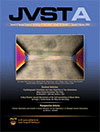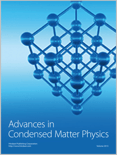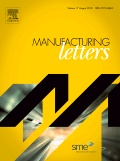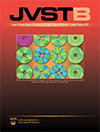
Vacuum
Scope & Guideline
Illuminating the Path of Scientific Discovery in Vacuum Technology
Introduction
Aims and Scopes
- Vacuum Technology and Applications:
Research focusing on the development and optimization of vacuum systems, including vacuum pumps, gauges, and their applications in diverse fields such as semiconductor manufacturing, materials science, and gas analysis. - Materials Science in Vacuum Conditions:
Studies addressing the impact of vacuum environments on material properties, including mechanical strength, corrosion resistance, and microstructural evolution of materials during various processes like deposition and welding. - Plasma and Ion Beam Technology:
Exploration of plasma-induced processes and ion beam applications in material synthesis, modification, and characterization, highlighting their role in enhancing material performance and functionality. - Nanomaterials and Nanostructures:
Investigations into the synthesis, characterization, and application of nanomaterials under vacuum conditions, focusing on their unique properties and potential uses in electronics, catalysis, and sensing. - Theoretical and Computational Studies:
Utilization of first-principles calculations and simulations to understand fundamental properties and behaviors of materials in vacuum, aiding in the prediction of experimental outcomes.
Trending and Emerging
- Advanced Nano-Characterization Techniques:
An increasing number of studies are focusing on advanced techniques for characterizing nanostructures and nanomaterials in vacuum environments, reflecting the growing importance of nanotechnology. - Sustainable and Green Technologies:
Research related to environmentally friendly processes and materials, particularly in the context of vacuum applications, is gaining traction as sustainability becomes a priority in scientific research. - Integration of Machine Learning and AI:
Emerging studies are incorporating machine learning and artificial intelligence to optimize vacuum processes and material properties, indicating a trend towards data-driven research. - Multifunctional Composite Materials:
There is a rising interest in the development of multifunctional materials that can perform under vacuum conditions, especially in energy storage and conversion applications. - Surface Engineering and Coatings:
Research focusing on innovative surface coatings and treatments to enhance performance in vacuum environments is trending, driven by the need for improved durability and functionality.
Declining or Waning
- Conventional Vacuum Techniques:
There has been a noticeable decline in studies solely focused on traditional vacuum techniques, as newer and more efficient technologies emerge, leading researchers to explore advanced methodologies. - Low-Temperature Applications:
Research pertaining to low-temperature vacuum applications appears to be waning, possibly due to the increasing focus on high-temperature and more versatile applications in various industries. - Basic Material Characterization:
Publications centered around basic characterization of materials in vacuum conditions are decreasing, likely overshadowed by more innovative and application-driven research topics. - Single-Focus Studies on Specific Materials:
There is a reduction in papers dedicated to the study of specific materials without a broader context of application or technological relevance, as interdisciplinary approaches gain precedence.
Similar Journals

Frontiers in Materials
Pioneering Transformative Applications in Materials Science.Frontiers in Materials, an esteemed journal published by FRONTIERS MEDIA SA, is a leading platform in the field of Materials Science, with a notable impact factor placing it in the Q2 category of its discipline as of 2023. Since its establishment as an Open Access journal in 2014, it has fostered considerable academic exchange, allowing researchers from around the globe to share their innovative findings and insights. Based in Lausanne, Switzerland, this journal not only emphasizes high-quality peer-reviewed articles but also prioritizes rapid dissemination of research, as evidenced by its commendable Scopus ranking of #62 out of 196 in Materials Science (miscellaneous). By consistently striving to bridge the gap between academia and practical applications, Frontiers in Materials serves as an invaluable resource for researchers, professionals, and students seeking to delve into cutting-edge advancements and transformative applications in materials science.

JOURNAL OF VACUUM SCIENCE & TECHNOLOGY A
Advancing the Frontiers of Vacuum Science.JOURNAL OF VACUUM SCIENCE & TECHNOLOGY A, published by the esteemed American Institute of Physics, is a leading journal in the field of materials science and applied physics, with an ISSN of 0734-2101 and an E-ISSN of 1520-8559. This publication serves as a vital platform for researchers and professionals focused on condensed matter physics, surfaces and interfaces, as well as coatings and films, contributing significantly to our understanding of vacuum technology and its applications. With a commendable Q2 ranking in key categories such as Condensed Matter Physics and Surfaces and Interfaces, the journal showcases rigorous research that pushes the boundaries of science and technology. The journal is particularly noted for its impact within the community, holding impressive Scopus rankings that highlight its relevance and influence. Although not an Open Access journal, it remains a crucial resource for academics seeking high-quality, peer-reviewed articles from 1970 through 2024. We invite you to explore the latest advancements and innovative findings that this journal presents, positioning you at the forefront of research in vacuum science.

KOVOVE MATERIALY-METALLIC MATERIALS
Connecting Global Insights in Materials ScienceKOVOVE MATERIALY-METALLIC MATERIALS, published by REDAKCIA KOVOVE MATERIALY, is a prominent journal embedded within the field of materials science, focusing particularly on metallic materials. With a history dating back to 1968, this Slovakian journal has made significant contributions to the understanding of materials chemistry, mechanical engineering, and the mechanics of materials. While currently classified in the Q4 category for Materials Chemistry and Mechanical Engineering, and Q3 for Metals and Alloys, it aims to provide a platform for high-quality research and novel findings in these domains. Furthermore, the journal is indexed within Scopus, reflecting its engagement with the global scientific community and its role in disseminating pivotal studies. Researchers, professionals, and students will find crucial insights and developments in the field, making it a valuable resource for those seeking to enhance their understanding of metallic materials and their applications.

Quantum Beam Science
Unleashing the Potential of Quantum Technology for TomorrowQuantum Beam Science, published by MDPI since 2017, is an esteemed open-access journal that occupies a pivotal role in the fields of atomic and molecular physics as well as nuclear and high-energy physics. Based in Switzerland, this journal embraces a global community of researchers dedicated to advancing our understanding of quantum phenomena through innovative experimental and theoretical approaches. With an impactful presence reflected in its category quartiles—ranking Q3 in both the Atomic and Molecular Physics, and Nuclear and High Energy Physics categories—the journal aims to bridge the gap between foundational research and practical applications of quantum technology. Since adopting an open-access model, Quantum Beam Science has fostered greater accessibility to groundbreaking studies, facilitating knowledge dissemination among researchers and professionals alike. This commitment to open science empowers the next generation of physicists to contribute to a rapidly evolving discipline, ensuring that critical advancements reach a diverse audience. Stay informed on the latest developments in quantum research as the journal covers a wide range of topics, making it an essential resource for students, academics, and professionals in the field.

Advances in Condensed Matter Physics
Bridging Ideas Across the Physics SpectrumAdvances in Condensed Matter Physics is a distinguished journal published by HINDAWI LTD, dedicated to the rapid dissemination of high-quality research in the field of condensed matter physics. Since its inception in 2008, this Open Access journal has facilitated wide accessibility to cutting-edge findings and theoretical advancements, with aims to foster collaboration and innovation within the scientific community. With an ISSN of 1687-8108 and an E-ISSN of 1687-8124, the journal covers an extensive range of topics, from quantum materials to nanotechnology, ensuring relevance and engagement across various sub-disciplines. As a testament to its impact in the field, it is ranked in the Q3 category for 2023 within Scopus and holds a position in the 34th percentile for physics and astronomy. The journal's continuous commitment to publishing significant exploratory research until 2024 makes it a pivotal resource for researchers, professionals, and students eager to stay on the leading edge of condensed matter physics advancements.

Letters on Materials
Bridging theory and practice in materials research.Letters on Materials, published by the Russian Academy of Sciences, Institute of Metals Superplasticity Problems, serves as a vital platform in the diverse field of materials science. Established in 2014 and running through 2024, this journal has carved a niche as a Q3 category publication, focusing on innovative research and developments in materials science and engineering. With its ISSN 2218-5046 and E-ISSN 2410-3535, it provides a unique opportunity for researchers and industry professionals to disseminate significant findings and theoretical advancements within the materials domain. While currently not categorized as open access, the journal maintains a global reach, promoting scientific dialogue and collaboration particularly within the Russian Federation and broader international audiences. Its placement within the 25th percentile in the Scopus rankings underscores its emerging significance, making it essential reading for anyone interested in cutting-edge materials research.

Manufacturing Letters
Fostering Collaboration for Cutting-edge Manufacturing Solutions.Manufacturing Letters is a premier academic journal published by Elsevier, dedicated to advancing the fields of Industrial and Manufacturing Engineering and Mechanics of Materials. Established in 2013, this journal has quickly gained recognition, achieving a Q2 ranking in both disciplines as of 2023, highlighting its significance in the rapidly evolving manufacturing landscape. With an ISSN of 2213-8463, Manufacturing Letters provides a platform for researchers and industry professionals to share critical insights and innovative findings that drive the manufacturing sector forward. The journal is indexed in Scopus, where it ranks in the top 65th percentile for Industrial and Manufacturing Engineering and the 61st percentile for Mechanics of Materials, reflecting its impact in the scientific community. While primarily accessible through subscription, Manufacturing Letters aims to facilitate knowledge exchange, promote sustainable practices, and foster collaboration among individuals passionate about enhancing manufacturing efficiency and material development. This journal is indispensable for anyone looking to contribute to or understand the future of manufacturing.

JOURNAL OF VACUUM SCIENCE & TECHNOLOGY B
Illuminating the Path of Scientific Discovery in Vacuum TechnologiesJOURNAL OF VACUUM SCIENCE & TECHNOLOGY B, published by the AIP Publishing, serves as a vital platform for the dissemination of research in the field of vacuum science and technology. With an ISSN of 2166-2746 and E-ISSN of 2166-2754, this peer-reviewed journal covers a wide array of topics, including condensed matter physics, electrical and electronic engineering, and various materials sciences, underscored by its Q3 quartile rankings across multiple categories in 2023. Although currently operating under a subscription model, the journal is recognized for its robust editorial standards and contribution to advancements in instrumentation and process technology, making it an essential resource for researchers and professionals seeking to stay at the forefront of the field. The journal's comprehensive approach addresses both theoretical and practical aspects of vacuum technology, fostering innovation and collaboration among the academic community. Additionally, the journal spans converged years of research from 1991 to 1992 and 2009 to 2024, reflecting its dynamic evolution and relevance in addressing contemporary scientific inquiries.

Metallurgical & Materials Engineering
Connecting researchers to the world of materials science.Metallurgical & Materials Engineering, published by Netherlands Press, is a prominent open access journal that has been advancing the field of metallurgical sciences and materials engineering since 2012. With an ISSN of 2217-8961 and an E-ISSN of 2812-9105, this journal provides a vital platform for researchers, professionals, and students to disseminate and access high-quality peer-reviewed research. As of 2023, it holds a Q4 quartile ranking in Mechanical Engineering and a Q3 ranking in Metals and Alloys, according to Scopus. This reflects its ongoing commitment to high standards despite being in a competitive sector. The journal covers a wide array of topics within the scope of materials science, with a focus on metallurgy and alloy technologies, and serves as a crucial resource for those engaged in innovative material development and application. Offering an open-access model emphasizes its dedication to making research widely available, thereby fostering collaboration and advancement in the materials engineering community. Join us in contributing to a dynamic and essential field of study.

JOURNAL OF WUHAN UNIVERSITY OF TECHNOLOGY-MATERIALS SCIENCE EDITION
Fostering Collaboration in Cutting-edge ScienceJOURNAL OF WUHAN UNIVERSITY OF TECHNOLOGY-MATERIALS SCIENCE EDITION, published by Wuhan University of Technology, stands as a prominent platform for the dissemination of innovative research in the field of Materials Science. With an ISSN of 1000-2413 and an E-ISSN of 1993-0437, this journal is committed to advancing the understanding of material composition, properties, and applications, contributing to the broader scientific community. Since its inception in 1994, the journal has maintained a steady trajectory of growth, culminating in a Q3 category ranking in Materials Science (miscellaneous) for the year 2023, positioning it within the 33rd percentile of its peers in Scopus rankings. By embracing rigorous peer-review standards and encouraging collaborative scholarship, the journal aims to inspire researchers, professionals, and students alike to explore cutting-edge advancements within the field. Although it does not currently operate under an open access model, its wealth of knowledge remains invaluable for those seeking to deepen their understanding of materials science and its transformative impact across various industries.